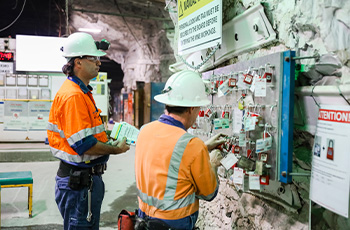ROLL OUT OF THE CIRITICAL CONTROL VERIFICATION PROGRAM

In FY22, we implemented a CCV program across our mine sites. The program allows us to regularly monitor controls in place to manage fatal and catastrophic hazards, ensure they’re fit-for-purpose and demonstrates our commitment to continual health and safety performance improvement.
Group Risk and Sustainability Principal, Heath Carney spoke about the work associated with the program rollout.
“Early in FY22, we conducted a ‘bow-tie’ analysis of our fatal hazards which helped us identify what controls we had in place to mitigate these risks. Once identified, we then determined which controls were ‘critical’.
“A critical control can be an engineered control, such as a physical barrier, or a systemic control like procedures. They’re crucial in preventing an event or mitigating its consequences. Taking fatal hazards as the example, the absence or failure of a critical control significantly increases the risk of a fatal hazard occurring, even if other controls are place,” Heath explained.
“Identifying critical controls is one thing, what’s important is the ongoing verification of these controls to ensure they’re in place and effective. This is the essence of our CCV program.
“The program requires subject matter experts and senior leaders at each site to participate in monthly on-the-job audits of critical controls using purpose-built verification checklists. The checklists focus on the practical implementation and effectiveness of each critical control,” Heath continued.
During the year, we developed critical control verification checklists for all our 15 fatal and catastrophic hazards.
The program is managed at each site, with individual verifiers assigned CCVs outside of their usual area of work. For example, a senior mine geologist may undertake a Mobile Plant Operator Competency CCV. Having the verification conducted by someone who does not regularly work in the area of the mine, or on the piece of equipment that is being inspected, brings a ‘fresh set of eyes’ to the work area and helps to pick up any weaknesses that may otherwise be overlooked.
“Any deficiencies identified during the monthly audits are entered into INX to allow us to assign responsibilities and track implementation of corrective actions. Serious weaknesses identified during the audits are escalated to Aurelia’s Senior Leadership Team, ensuring that the Company’s leadership has visibility of how we’re improving and managing these risks,” Heath concluded.
